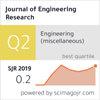Use of recycled aggregates as filter support and filter media for decentralized water filtration systems
IF 0.9
4区 工程技术
Q3 ENGINEERING, MULTIDISCIPLINARY
引用次数: 0
Abstract
Clean drinking water is crucial for maintaining public health and can be considered a fundamental right of people. Unfortunately, access to potable water is limited for residents of developing and underdeveloped countries, especially in rural communities. Conventional treatment systems for such regions are challenging in terms of installation, operation, and maintenance. An emerging problem of rapid urbanization and proliferating construction industry is huge quantities of Construction and Demolition (C & D) waste, which needs proper reuse and/or disposal. A simultaneous solution to these twin problems is the formulation of a decentralized water filtration system using C & D waste aggregates. In the current study, small-scale (5-lt capacity), decentralized water filtration systems were designed and tested for the treatment of surface water samples. Fresh aggregates were replaced by C & D waste aggregates progressively in the drainage media, support media, and filter media; resulting in a total of seven test filtration devices. The effectiveness of such filters was evaluated for treating river water samples. It was found that the filters prepared with C & D waste aggregates were successful in the removal of turbidity, total solids, and total dissolved solids (TDS). Removal efficiencies up to 98% for turbidity, 86% for total solids, and 61% for the TDS were observed for different combinations of fresh and recycled aggregates in these filters. The results also show that filters made with only recycled aggregates can also yield high levels of contaminant removal and cleaner water. Further, the color and odor of the raw water were also significantly improved. These results show that C & D waste can be successfully incorporated into decentralized water treatment systems and can result in high-quality water through low-cost and low-tech, easy-to-maintain/operate devices.

使用再生骨料作为分散式水过滤系统的过滤支撑和过滤介质
清洁饮用水对维持公众健康至关重要,可被视为人民的一项基本权利。不幸的是,发展中国家和不发达国家的居民获得饮用水的机会有限,特别是在农村社区。这些地区的常规处理系统在安装、操作和维护方面具有挑战性。快速城市化和建筑业激增的一个新问题是大量的建筑和拆迁(C &;D)废物,需要适当的再利用和/或处理。同时解决这两个问题的方法是使用C &;D废物集料。在目前的研究中,设计并测试了小型(5-lt容量)分散式水过滤系统,用于处理地表水样品。新鲜骨料用C &;D废物在排水介质、支撑介质和过滤介质中逐渐聚集;结果共测试了七个过滤装置。对这种过滤器处理河流水样的效果进行了评价。结果表明,用C &;D废物集料在去除浊度、总固形物和总溶解固形物(TDS)方面取得了成功。在这些过滤器中观察到不同组合的新鲜和再生骨料对浊度的去除效率高达98%,对总固体的去除效率为86%,对TDS的去除效率为61%。研究结果还表明,仅用再生骨料制成的过滤器也能产生高水平的污染物去除和更清洁的水。此外,原水的颜色和气味也有明显改善。这些结果表明,C &;D废物可以成功地纳入分散的水处理系统,并可以通过低成本和低技术,易于维护/操作的设备产生高质量的水。
本文章由计算机程序翻译,如有差异,请以英文原文为准。
求助全文
约1分钟内获得全文
求助全文
来源期刊

Journal of Engineering Research
ENGINEERING, MULTIDISCIPLINARY-
CiteScore
1.60
自引率
10.00%
发文量
181
审稿时长
20 weeks
期刊介绍:
Journal of Engineering Research (JER) is a international, peer reviewed journal which publishes full length original research papers, reviews, case studies related to all areas of Engineering such as: Civil, Mechanical, Industrial, Electrical, Computer, Chemical, Petroleum, Aerospace, Architectural, Biomedical, Coastal, Environmental, Marine & Ocean, Metallurgical & Materials, software, Surveying, Systems and Manufacturing Engineering. In particular, JER focuses on innovative approaches and methods that contribute to solving the environmental and manufacturing problems, which exist primarily in the Arabian Gulf region and the Middle East countries. Kuwait University used to publish the Journal "Kuwait Journal of Science and Engineering" (ISSN: 1024-8684), which included Science and Engineering articles since 1974. In 2011 the decision was taken to split KJSE into two independent Journals - "Journal of Engineering Research "(JER) and "Kuwait Journal of Science" (KJS).
 求助内容:
求助内容: 应助结果提醒方式:
应助结果提醒方式:


